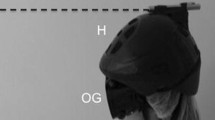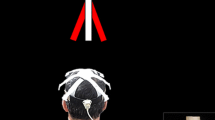Abstract
Purpose
It has been suggested that the cause of the balance disorder seen in adolescent idiopathic scoliosis (AIS) originates from the central nervous system. However, the extent of the balance problem and the dysfunction of which part of the central nervous system has not been investigated in detail. This study aimed to correlate the values obtained by balance analysis and cerebellum volume measurement in female individuals with AIS with healthy individuals.
Methods
Cerebellum volume was calculated via the cloud-based software “https://volbrain.upv.es” using brain magnetic resonance images of 27 healthy and 26 individuals with AIS. The duration of stay in the test positions, the movement strategy used during this time and the amount of postural sway were analyzed by using a computer-assisted force platform and compared statistically.
Results
Significant differences were found between the AIS and control groups in cerebellum total volume, vermis cerebelli volume (cm3), and trunk oscillation velocity (mm/s) parameters (p < 0.05). Cerebellum and vermis cerebelli volumes were found to be lower and trunk oscillation velocity was found to be greater in patients with AIS.
Conclusion
Balance problems in patients with AIS are correlated with decreased cerebellum volume and increased trunk oscillation velocity.



Similar content being viewed by others
References
Jada A, Mackel CE, Hwang SW, Samdani AF, Stephen JH, Bennett JT et al (2017) Evaluation and management of adolescent idiopathic scoliosis: a review. Neurosurg Focus 43(4):E2
Kuznia AL, Hernandez AK, Lee LU (2020) Adolescent idiopathic scoliosis: common questions and answers. Am Fam Phys 101(1):19–23
Simoneau M, Mercier P, Blouin J, Allard P, Teasdale N (2006) Altered sensory-weighting mechanisms is observed in adolescents with idiopathic scoliosis. BMC Neurosci 19(7):68
Liu Y, Li X, Dou X, Huang Z, Wang J, Liao B, Zhang X (2022) Correlational analysis of three-dimensional spinopelvic parameters with standing balance and gait characteristics in adolescent idiopathic scoliosis: a preliminary research on Lenke V. Front Bioeng Biotechnol 30(10):1022376. https://doi.org/10.3389/fbioe.2022.1022376
Addai D, Zarkos J, Bowey AJ (2020) Current concepts in the diagnosis and management of adolescent idiopathic scoliosis. Childs Nerv Syst 36(6):1111–1119
Nault ML, Allard P, Hinse S, Le Blanc R, Caron O, Labelle H et al (2002) Relations between standing stability and body posture parameters in adolescent idiopathic scoliosis. Spine 27(17):1911–1917
Gargano G, Oliva F, Migliorini F, Maffulli N (2022) Melatonin and adolescent idiopathic scoliosis: the present evidence. Surgeon 20(6):e315–e321
Lee SY, Ch’ng PY, Wong TS, Ling XW, Chung WH, Chiu CK, Chan CYW, Lean ML, Kwan MK (2023) Patients’ perception and satisfaction on neck and shoulder ımbalance in adolescent ıdiopathic scoliosis. Glob Spine J 13(3):752–763. https://doi.org/10.1177/21925682211007795
Barmack NH (2003) Central vestibular system: vestibular nuclei and posterior cerebellum. Brain Res Bull 60:511–541
Dupont C, Castellanos-Ryan N, Séguin JR, Muckle G, Simard MN, Shapiro GD, Herba CM, Fraser WD, Lippé S (2018) The predictive value of head circumference growth during the first year of life on early child traits. Sci Rep 8(1):9828. https://doi.org/10.1038/s41598-018-28165-8
Hshieh TT, Fox ML, Kosar CM, Cavallari M, Guttmann CR, Alsop D, Marcantonio ER, Schmitt EM, Jones RN, Inouye SK (2016) Head circumference as a useful surrogate for intracranial volume in older adults. Int Psychogeriatr 28(1):157–162. https://doi.org/10.1017/S104161021500037X
Haumont T, Gauchard GC, Lascombes P, Perrin PP (2011) Postural instability in early-stage idiopathic scoliosis in adolescent girls. Spine 36(13):E847–E854
Kuru T, Yeldan İ, Dereli EE, Özdinçler AR, Dikici F, Çolak İ (2016) The efficacy of three-dimensional Schroth exercises in adolescent idiopathic scoliosis: a randomised controlled clinical trial. Clin Rehabil 30(2):181–190. https://doi.org/10.1177/0269215515575745
Yanagihara D (2010) Mechanisms of locomotor control in the cerebellum. Brain Nerve 62(11):1149–1156
Fino PC, Peterka RJ, Hullar TE, Murchison C, Horak FB, Chesnutt JC et al (2017) Assessment and rehabilitation of central sensory impairments for balance in mTBI using auditory biofeedback: a randomized clinical trial. BMC Neurol 17(1):41. https://doi.org/10.1186/s12883-017-0812-7
Kubat O, Ovadia D (2020) Frontal and sagittal imbalance in patients with adolescent idiopathic deformity. Ann Transl Med 8(2):29. https://doi.org/10.21037/atm.2019.10.49
Payas A, Batin S, Kurtoğlu E, Arik M, Seber T, Uçar İ et al (2023) Is the integration problem in the sensoriomotor system the cause of adolescent idiopathic scoliosis? J Pediatr Orthop 43(2):e111–e119. https://doi.org/10.1097/BPO.0000000000002300
Grimaldi G, Manto M (2012) Topography of cerebellar deficits in humans. Cerebellum 11(2):336–351. https://doi.org/10.1007/s12311-011-0247-4
Hytönen M, Pyykkö I, Aalto H, Starck J (1993) Postural control and age. Acta Otolaryngol 113(2):119–122. https://doi.org/10.3109/00016489309135778
Chen PQ, Wang JL, Tsuang YH, Liao TL, Huang PI, Hang YS (1998) The postural stability control and gait pattern of idiopathic scoliosis adolescents. Clin Biomech (Bristol, Avon) 13(1 Suppl 1):S52–S58. https://doi.org/10.1016/s0268-0033(97)00075-2
Herman R, Mixon J, Fisher A, Maulucci R, Stuyck J (1985) Idiopathic scoliosis and the central nervous system: a motor control problem. The Harrington lecture, 1983. Scoliosis Research Society. Spine 10(1):1–14
Liu T, Chu WC, Young G, Li K, Yeung BH, Guo L et al (2008) MR analysis of regional brain volume in adolescent idiopathic scoliosis: neurological manifestation of a systemic disease. J Magn Reson Imaging 27(4):732–736. https://doi.org/10.1002/jmri.21321
Acer N, Bastepe-Gray S, Sagiroglu A, Gumus KZ, Degirmencioglu L, Zararsiz G et al (2018) Diffusion tensor and volumetric magnetic resonance imaging findings in the brains of professional musicians. J Chem Neuroanat 88:33–40. https://doi.org/10.1016/j.jchemneu.2017.11.003
Ding H, Qin W, Jiang T, Zhang Y, Yu C (2012) Volumetric variation in subregions of the cerebellum correlates with working memory performance. Neurosci Lett 508(1):47–51. https://doi.org/10.1016/j.neulet.2011.12.016. (Epub 2011 Dec 22 PMID: 22206834)
Stoodley CJ (2012) The cerebellum and cognition: evidence from functional imaging studies. Cerebellum 11(2):352–365. https://doi.org/10.1007/s12311-011-0260-7. (PMID: 21373864)
Edwards CR, Newman S, Bismark A, Skosnik PD, O’Donnell BF, Shekhar A, Steinmetz JE, Hetrick WP (2008) Cerebellum volume and eyeblink conditioning in schizophrenia. Psychiatry Res 162(3):185–194. https://doi.org/10.1016/j.pscychresns.2007.06.001
Cooper CP, Shafer AT, Armstrong NM, An Y, Erus G, Davatzikos C, Ferrucci L, Rapp PR, Resnick SM (2023) Associations of baseline and longitudinal change in cerebellum volume with age-related changes in verbal learning and memory. Neuroimage 15(272):120048. https://doi.org/10.1016/j.neuroimage.2023.120048
Shi L, Wang D, Hui SC, Tong MC, Cheng JC, Chu WC (2013) Volumetric changes in cerebellar regions in adolescent idiopathic scoliosis compared with healthy controls. Spine J 13(12):1904–1911. https://doi.org/10.1016/j.spinee.2013.06.045
Funding
This study was not funded by any commissions of public, commercial, or not-for-profit sectors for the conduct of research, study design, and collection, analysis, and interpretation of the data writing the report, and/or decision of the article for publication.
Author information
Authors and Affiliations
Contributions
SB, MD (Contribution: study design, performed measurements, manuscript preparation). AP, PhD (Contribution: writing—original draft, visualization, methodology, investigation). Emre BAL, MD (Contribution: Evaluation of patients, manuscript preparation). YE, MD (Contribution: writing—review & editing). EK, PhD (Contribution: Formal analysis, data curation). İU, PhD (Contribution: study design, writing—review & editing). MA, MD (Contribution: Evaluation of patients, manuscript preparation). TS, MD (Contribution: performed measurements, manuscript preparation). BKV, PhD (Contribution: performed measurements, manuscript preparation). EKU, MD (Contribution: Writing—original draft, formal analysis). AKB, MD (Contribution: Evaluation of patients, manuscript preparation). DE, MD (Contribution: Evaluation of patients, manuscript preparation). EU, PhD (Contribution: Validation, supervision, methodology).
Corresponding author
Ethics declarations
Conflict of Interest
The authors have no conflict of interest to declare.
Ethical approval
The study protocol was approved by the local Clinical Research Ethics Committee numbered 2021/554. All procedures were performed in the Kayseri City Education and Research Hospital, Kayseri, Turkey.
Informed consent
Written informed consent was obtained from each patient. The study was conducted in accordance with the principles of the Declaration of Helsinki.
Additional information
Publisher's Note
Springer Nature remains neutral with regard to jurisdictional claims in published maps and institutional affiliations.
Rights and permissions
Springer Nature or its licensor (e.g. a society or other partner) holds exclusive rights to this article under a publishing agreement with the author(s) or other rightsholder(s); author self-archiving of the accepted manuscript version of this article is solely governed by the terms of such publishing agreement and applicable law.
About this article
Cite this article
Batin, S., Payas, A., Bal, E. et al. Evaluation of cerebellum volume and trunk oscillation velocity in cases with adolescent idiopathic scoliosis: a preliminary report. Eur Spine J 32, 4012–4019 (2023). https://doi.org/10.1007/s00586-023-07948-2
Received:
Revised:
Accepted:
Published:
Issue Date:
DOI: https://doi.org/10.1007/s00586-023-07948-2




